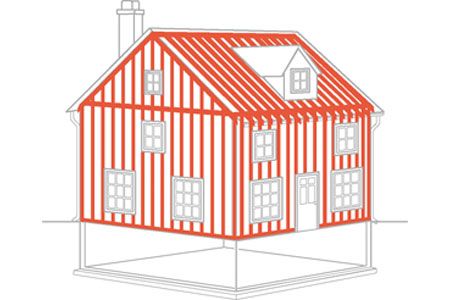House framing is the skeleton of your home, providing the essential structure that supports everything from walls and floors to roofs and finishes. A well-constructed frame ensures your home’s longevity and stability. This guide will walk you through the fundamentals of house framing, from basic concepts to advanced techniques and innovations.
Understanding the Basics of House Framing
House framing involves creating a building’s structural support system. Many homeowners frame their homes using vertical studs, horizontal plates, and diagonal bracing to form walls, floors, and roofs. The frame distributes the building’s weight and contents to the foundation, giving the structure more stability.
Modern framing methods have evolved from traditional post-and-beam construction to more efficient and cost-effective techniques. Today, platform framing is the most common method used in residential construction. This approach involves building one story at a time, with each floor serving as a platform for constructing the next level.
House Framing Diagram
Silva’s chosen method for constructing a home uses one-story “platforms” with 8- or 9-foot stud walls and plywood-sheathed subfloors. He frames these platforms on top of one another until it’s time to add a roof, as follows:
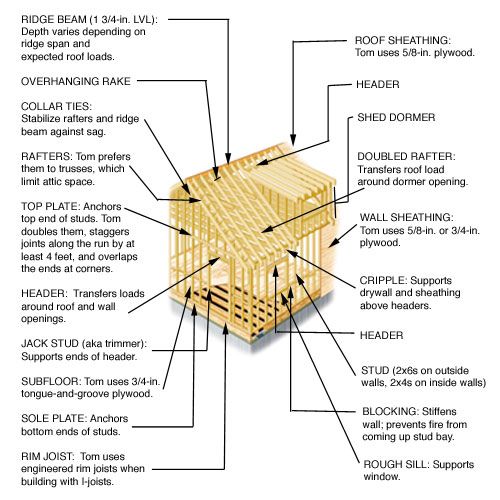
Essential Tools and Materials for Framing
Successful framing requires the right tools and materials, such as power tools and lumber. Each of the following elements helps create a strong and durable frame.
Power Tools for Efficient Framing
Power tools have revolutionized the framing process by reducing construction time. Key power tools for framing include the following:
- Circular saws
- Pneumatic nail guns
- Power drills
- Reciprocating saws
Pneumatic nail guns in particular have become indispensable in modern framing. These tools have facilitated quicker assembly since their widespread adoption in the mid-1970s.
Hand Tools Every Framer Needs
While power tools dominate modern framing, you’ll still need hand tools for precision work and situations where power tools are impractical. Some hand tools you might use include the following:
- Carpenter’s pencils
- Framing hammers
- Levels
- Measuring tape
- Speed squares
Choosing the Right Lumber for Your Frame
Selecting the appropriate lumber will ensure a strong frame. Consider the following when deciding on lumber:
- Choose lumber appropriate for your climate and local building codes.
- Use dry wood stamped “S-dry” or “KD” (kiln-dried) to minimize warping and twisting.
- Use engineered lumber products for specific applications.
As Silva suggests, “Keep wood dry. Block stacks off the ground and cover them with tarps” to maintain your lumber’s quality before use.
Types of House Framing Methods
House framing has evolved in recent years, with different methods developed to suit various architectural styles and construction needs. Understanding these methods can help you choose the best approach for your project.
Platform Framing
Platform framing is the most common method used in modern residential construction. This technique involves building one story at a time with each floor functioning as a platform for the next level. As we noted earlier, Silva often uses this method.
The benefits of platform framing include the following:
- Allows for efficient insulation installation
- Enables easy construction and modifications
- Provides natural fire stops between floors
Post-And-Beam Framing
Post-and-beam framing is one of the oldest framing methods. It uses large wooden posts and beams to create the structural framework. Contractors often apply this method in timber frame construction because it can create dramatic open spaces.
Key characteristics of post-and-beam framing include the following:
- Allows for large, open interior spaces
- Often leaves structural elements exposed for aesthetic appeal
- Requires skilled craftsmanship
Balloon Framing
Balloon framing was popular during the Victorian era. This framing method uses extra long studs that extend from the sill plate to the roof. While less common today due to fire safety concerns, this technique can still be valuable when renovating older homes.
Notable features of balloon framing include the following:
- Presents challenges for fire blocking between floors
- Requires longer lumber pieces
- Studs run continuously from foundation to roof
Step-By-Step Process of Framing a House
Framing a house is a complex process that requires careful planning and execution. Per This Old House general contractor Tom Silva, “Shortcuts in framing are the biggest mistake you can make, although it may take four or five years before the sagging, the bouncing, and the movement start to show up.” Here’s a general overview of the steps involved in framing a typical residential structure.
Laying the Foundation
The foundation provides the base upon which the entire frame will rest. Follow these steps to lay your foundation:
- Excavate the site.
- Pour footings and foundation walls.
- Install anchor bolts to attach the sill plate.
Constructing the Subfloor
The subfloor creates the base for the first story of the house. To construct your subfloor, do the following:
- Install sill plates on the foundation.
- Place floor joists at regular intervals, typically 16 inches apart. According to Silva, “placing joists, studs, and rafters exactly 16 inches apart gives solid support to panel ends.”
- Lay plywood or oriented strand board (OSB) sheathing.
Erecting Wall Frames
Wall framing forms your home’s vertical structure. Take the following steps to erect your wall frames:
- Construct wall frames on the ground, including top and bottom plates and studs.
- Raise and secure the walls in place.
- Install headers above doors and windows.
Installing Roof Trusses
Roof framing completes your home’s structural envelope. You’ll likely need to do the following when framing your roof:
- Set prefabricated roof trusses or construct rafters on-site.
- Install roof sheathing.
- Add any necessary bracing.
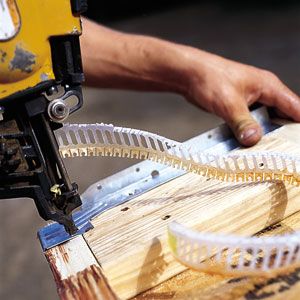
Critical Components of a Strong Frame
A strong frame relies on several key components that distribute loads and provide stability, including the following:
- Floor and ceiling joists must undergo proper installation to support the floors and ceilings.
- Headers and beams transfer loads around wall openings and across large spans.
- Load-bearing walls support the weight of the floors and roof above them.
Advanced Framing Techniques for Efficiency
Advanced framing techniques, also known as optimum value engineering (OVE), aim to reduce material usage and improve energy efficiency without compromising structural integrity. Consider the following techniques when framing your home:
- Align framing members vertically throughout the structure.
- Minimize the use of headers in non-load-bearing walls.
- Use 2-by-6 studs at 24-inch centers instead of 2-by-4 studs at 16-inch centers.
- Use single top plates with metal tie plates at joints.
Implementing these techniques can result in significant material savings and improve your home’s thermal performance.
Common Framing Mistakes and How To Avoid Them
Even experienced framers can make mistakes that compromise a structure’s integrity. Try to avoid the following common errors when framing your home:
- Failing to account for lumber shrinkage
- Improper spacing of framing members
- Inadequate bracing during construction
- Overdriving nails, which reduces their holding power
To avoid these issues, always follow building codes, use proper techniques, and frame basement walls with the same care as above-grade construction.
Innovations in Framing Technology
The framing industry continues to evolve with new materials and technologies designed to improve efficiency, strength, and sustainability. Check out some of these advancements below.
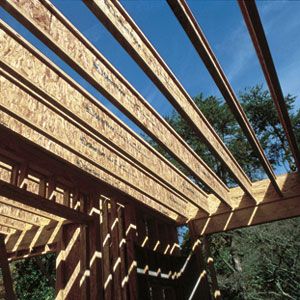
Energy-Efficient Framing Systems
Multiple framing system innovations—including structural insulated panels (SIPs), insulating concrete forms (ICFs), and framing techniques to reduce thermal bridging—focus on improving energy efficiency.
Engineered Lumber Products
Engineered lumber varieties, such as I-joists, LVL beams, or oriented strand lumber (OSL), offer superior strength and consistency compared to traditional sawn lumber. These products can span longer distances and resist warping and twisting.
Metal Connectors and Fasteners
Metal connectors and specialized fasteners have become standard in modern framing. There are hundreds of galvanized steel fitting types, from joist hangers to hurricane straps, with new ones coming on the market almost every month.
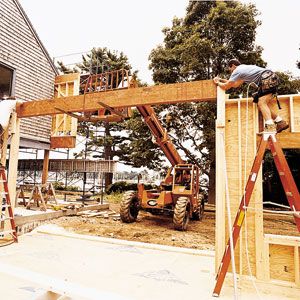
Tips for Weatherproofing Your Frame
Protecting your frame from the elements will prevent moisture damage and extend your home’s lifespan. Consider the following weatherproofing tips when framing your home:
- Ensure proper flashing around windows, doors, and other openings.
- Implement adequate ventilation in attic spaces.
- Install a proper moisture barrier on exterior walls.
- Use treated lumber for ground contact areas.
Cost Considerations in House Framing
House framing costs can vary based on the structure’s size and complexity, materials needed, and local labor costs.
Lumber pricing fluctuates with market conditions. Engineered lumber may cost more but offers greater strength and durability. Specialty metal connectors and fasteners can also increase material costs, but you’ll need them for most modern framing techniques.
Labor costs vary widely based on geographical location and contractor experience. While DIY framing can save money upfront, professional framers offer experience and efficiency, potentially saving money and time in the long run by avoiding costly mistakes.
Building Codes and Inspections for Framing
You’ll need to adhere to building codes to ensure your home’s safety and longevity. Familiarize yourself with local building codes before starting your project and schedule inspections at key points during the framing process. Always obtain the necessary permits before beginning construction.
Professionals are well-versed in permitting and inspection processes, but you can always check with the city permits office to ensure your chosen contractor is doing everything by the book.
Maintaining Your House Frame Over Time
While a well-built frame should last for decades, proper maintenance can extend its life and prevent issues. Stay on top of the following maintenance tasks to extend your frame’s lifespan:
- Address any foundation issues promptly to prevent stress on the frame.
- Conduct regular inspections for signs of moisture damage or pest infestation.
- Maintain proper ventilation to prevent moisture buildup.
- Repair or replace damaged framing components as needed.
Our Conclusion
House framing is an important aspect of home construction that requires careful planning, quality materials, and skilled execution. Whether you’re building a new home or renovating an existing structure, understanding the principles of framing can help you make informed decisions and ensure your home’s longevity. While innovations in materials and techniques have improved the efficiency and performance of modern framing, the fundamental goal remains the same—to create a strong, stable structure that will stand the test of time.
